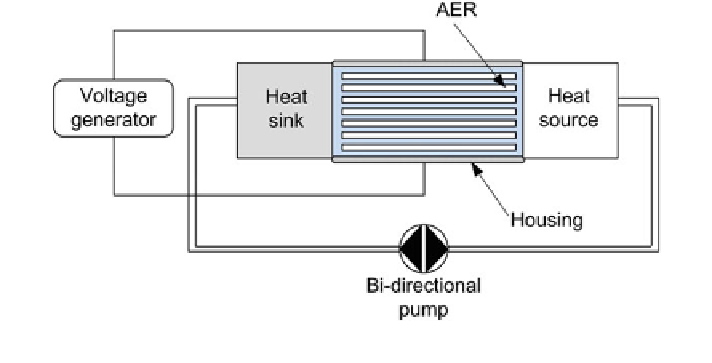Environmental Engineering Reference
In-Depth Information
Fig. 10.6 Schematic presentation of a refrigeration or a heat pumping system with an AER
entering the heat source where it can absorb heat. The device operates by repeating
those four steps. After a certain number of steps the steady state is reached and a
temperature span between the heat sink and heat source is established. An important
characteristic of a device with an AER is that the temperature span between the heat
sink and the heat source can be a factor greater than the adiabatic temperature
change of the electrocaloric material [
9
].
O
bolt et al. [
47
] performed a numerical simulation in order to compare the
performance of a magnetocaloric and an electrocaloric active heat regenerator (i.e.,
the maximum speci
ž
c cooling power and the COP). The geometry of the regen-
erator was the same for both cases. In the
rst case, gadolinium and in the second
case a multilayer capacitor constructed from layers of Pb(Sc
0.5
Ta
0.5
)O
3
ceramics
and electrodes were de
eld change in
the case of the magnetocaloric active regenerator was set to be 1 T. On the other
hand, the electrocaloric active regenerator was subjected to different changes of the
electric
ned as the active materials. The magnetic
eld change of 77.4 MVm
−
1
eld. The results revealed that for an electric
the maximum speci
c cooling power of the electrocaloric active regenerator was
around 500 Wkg
−
1
(for a temperature span of 15 K). These results show that the
characteristics of the AER can exceed the characteristics of the active magnetoc-
aloric regenerator considered in the study.
In another paper, Guo et al. [
48
] numerically analysed the performance of a
micro-scale electrocaloric cooling device with an active heat regenerator. The
regenerator was considered to be composed of P(VDF-TrFE-CFE) terpolymer
plates (thickness of 10
µ
m), with a total length of the regenerator of 2 mm. In order
to pump the
uid through the regenerator diaphragm actuators were assumed. Their
numerical results indicate that if the system under investigation would be operating
at a temperature span of 15 K an ef
fl
ciency equal to 31 % of the Carnot COP and a
cooling-power density of 3 Wcm
−
2
could be achieved.

Search WWH ::

Custom Search